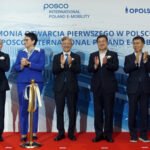Doosan’s chicken-frying robot performs its task at a high school (Courtesy of Doosan Robotics)
South Korean regulators have ordered Doosan Robotics Inc. to amend the securities prospectus it had submitted last week for its merger with Doosan Bobcat Inc., after it provoked sever criticism from Bobcat’s minority shareholders and politicians.
After a review of the prospectus, the Financial Supervisory Service (FSS) said the document constituted a case in which it was not submitted in an appropriate form, contained false statements or descriptions on important matters, or failed to clarify important matters, Doosan Robotics said in a regulatory filing on Wednesday.
Therefore, the original document on the merger could hinder investors making a reasonable investment judgement, or cause a significant misunderstanding to investors, Doosan cited the FSS as saying.
Robotics, a collaborative robot maker, needs to submit an amended prospectus within the next three months.
On Sunday, Doosan Group announced that it would complete a merger with Bobcat by early next year, a move aimed at prodding Bobcat to take an active role in expanding their parent Doosan Group’s business through M&As.
Doosan Bobcat’s all-electric skid-steer loader
The announcement met with a strong backlash from investors and led to a call for a revision to the Capital Markets Act to properly assess the valuations of the companies to be merged.
Shareholder activists and opposition party’s lawmakers argued the 1:1 merger ratio between Robotics and Bobcat significantly inflated loss-making Robotics’ value or sharply diminished the enterprise value of Bobcat, the group’s cash cow.
AGAINST VALUE-UP PROGRAM
Their combination is also viewed as running counter to the so-called Corporate Value-up Program, initiated and backed by the FSS to tackle the Korea Discount, a tendency for Korean companies to be undervalued relative to their intrinsic value.
Shares in Bobcat have continued their downward spiral for five trading days in a row. On Friday, the construction machinery maker ended down 3.7% at 42,500 won ($18), its eight-month low.
Robotics’ share price hit its lowest level in more than five months, closing down 0.95% at 72,700 won.
Doosan Enerbility Co., a power plant engineering company, edged down 0.32% to finish at 18,870 won, its weakest level in two months.
To combine Robotics and Bobcat, Robotics will take over Enerbility’s 46% stake in Bobcat and the remainder from the stock market. That would cause minority shareholders in Enerbility 271,000 won ($195) losses for every 100 shares, Kim Hyung-jun, a Democratic Party lawmaker, claimed.
Doosan Corp., a holding company, is Enerbility’s largest shareholder with a 30.39% stake.
Doosan Enerbility’s hydrogen gas turbine model showcased at CES 2024
The Korean Corporate Governance Forum (KCGF), a shareholder activism group, argued in a seminar this week that no laws exist in other countries that allow a 1:1 merger between two companies, one of which generates about 180 times more revenue.
It urged regulators to scrutinize the Robotics-Bobcat merger before granting approval.
In the second quarter of this year, Bobcat earned 239.5 billion won in operating profit on sales of 2.2 trillion won.
In the quarter, Robotics widened losses to 7.9 billion won versus a 5.4-billion-won shortfall in the year prior. Its revenue stood at 14.4 billion won in the same period.
WITHIN BOUNDS OF LAW
Despite strong criticism about the marriage between the two Doosan Group units, some analysts doubt whether Doosan would change its proposed 1:1 merger ratio, saying it falls within the bounds of Korean law.
By Min-Kyung Shin
radio@hankyung.com
Yeonhee Kim edited this article















